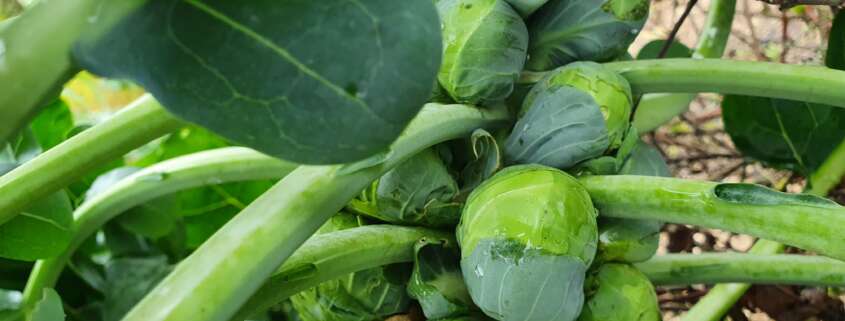Brussels sprouts
It’s harvest time, at least if you sowed in spring. Brussels sprouts are often unloved, but what a shame! it is a vegetable rich in fiber, vitamin C, potassium, etc. And I forget!
Brussels sprouts
Brussels sprouts get their name from the city of Brussels in Belgium, where they were popular in the 16th century. It is believed that this variety of cabbage was first cultivated in the region. The story goes that Brussels sprouts were introduced to France in the 19th century and gained popularity in Europe and the United States afterward.
If we want to be a little more precise, Brussels sprouts are not native to Brussels. The variety is believed to have been developed from wild cabbages in Belgium.
And what’s more, they aren’t really individual cabbages, but rather small heads that grow along the stem of the plant. Each “cabbage” is actually a small shoot that looks like a miniature cabbage. So although the name suggests it is a single cabbage, it is actually a collection of small, tight shoots.
Either way, they have a growing cycle that typically lasts 90 to 100 days from planting to harvest.
Culture
In spring, in March-April, we will sow the seeds indoors or directly in the garden. You can also buy already grown plants. They prefer rich, well-drained soils.From May-June, the plants are ready to be transplanted into the garden when temperatures are no longer too cold. Make sure to space them about 40 centimeters apart to facilitate their growth.Then, and until harvest, Brussels sprouts require regular care, including regular watering, especially in cases of drought. Be sure to remove weeds to avoid competition.The harvest period is generally in autumn. The small heads form along the stem of the plant. You can start harvesting once they have reached a sufficient size of 2 to 3 centimeters in diameter. We often do this after the first frosts. Cool temperatures often improve the flavor of Brussels sprouts.These steps may vary depending on the climate in your area.
Harvesting Tips
Start harvesting Brussels sprouts when the heads are firm and a suitable size (about 2 to 3 cm in diameter). You don’t need to harvest all the cabbages at once, as the plants will continue to produce new shoots as the season progresses.Brussels sprouts often benefit from a period of light frost, which can improve their flavor by converting starches into sugars. Harvesting after a light frost can make them sweeter.Start harvesting from the bottom of the plant and work your way up gradually. This allows the top buds to continue to develop.Use clean, sharp scissors to cut the stems just above the leaves. This prevents damage to the plant and encourages continued growth.Wait until most on the plant have reached a sufficient size before beginning harvest. This guarantees uniform maturation.After harvesting, store them in the refrigerator. They can also be stored in a cool place. Be sure to remove any outer leaves that may be damaged.
The best recipe
There are so many quality recipes with this vegetable that it is difficult to sort through them.Come on, let’s get started!Roasted Brussels sprouts with honey and mustard:To prepare this recipe, we need:- 500 g Brussels sprouts, cleaned and cut in half- 2 tablespoons of olive oil- 2 tablespoons of honey- 1 tablespoon of mustard- Salt and pepper, to taste- Grated nutmeg (if you like!)- Toasted sesame seeds to garnishStart by preheating the oven to 200°C.In a large bowl, toss the Brussels sprouts with the olive oil, honey, mustard, salt and pepper. Make sure the sprouts are well coated.Arrange the Brussels sprouts on a baking sheet, cut side down, so that they are nicely browned.Roast in the oven for about 20-25 minutes or until the vegetables are golden and caramelized.If you like, add a pinch of grated nutmeg for extra flavor.Garnish with toasted sesame seeds just before serving.You can serve them as a side or even as a main dish with rice or quinoa. Enjoy your food!




Leave a Reply
Want to join the discussion?Feel free to contribute!